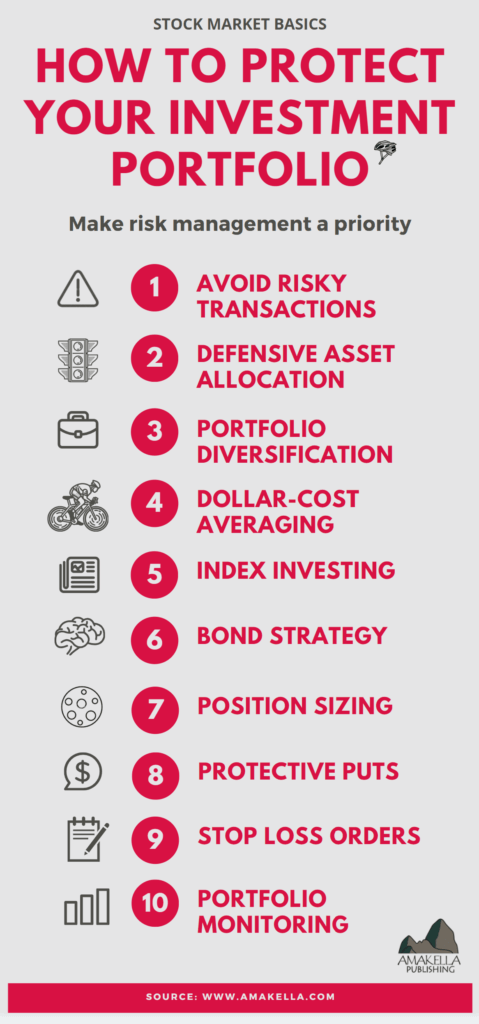10 Things Investors Can Do To Protect Their Stock Portfolios
Investment strategies that include risk management measures at their core will be better prepared to protect stock portfolios from a stock market crash

Managing risks is a key part of the stock market investment process. Investors must be aware of the possibility of losing the capital they invest in financial securities, particularly when the next stock market crash inevitably comes knocking at their door.

In general terms, there is an inverse relationship between risk and reward. Lower risk investments provide more limited gains, but they are expected to be less susceptible to the risks associated with market fluctuations. Higher risk is likely to produce greater financial gains, but there is also a higher likelihood of significant investment losses.
There is also an inverse relationship between investing time frame and level of risk. Depending on how conservative or aggressive a strategy is, attempts to maximize profits in short periods will normally involve investments with higher levels of risk than those investment strategies that would take longer to produce similar levels of growth.
The focus of a risk management approach, as it applies to stock market participants, is to protect their stock portfolios. This can be facilitated by the systematic practice of identifying the factors that could negatively affect the chances of reaching the intended profit targets, assessing their probability of occurrence and their likely severity, and defining preventive and corrective actions to take to minimize their adverse effects on a portfolio.
Being such a crucial aspect of the long-term resilience of a stock portfolio, the inclusion of risk management measures should be at the core of every stock market strategy. Here are ten practical actions that stock investors can consider when planning and implementing their investing strategies.

1. Avoiding risky transactions. Learning to recognize and avoid high-risk investments can make a big difference in the health of a portfolio. Staying away from shares of struggling companies, junk bonds, penny stocks, and avoiding the selling of naked calls and unprotected puts, among others, can provide an initial filter before applying other risk mitigation measures.
2. Diverse asset allocation. An asset allocation informed by risk management considerations contributes to the development of a more resilient investment strategy. A portfolio with a combination of stocks, ETFs, index funds, bonds, and commodities —either as direct investments or as the underlying securities of derivative instruments, like options and futures— will be more resilient than a portfolio made out only of stocks.
3. Portfolio diversification. Broad diversification of investments across different sectors of the economy is also important in terms of risk management. The more independent the different types of securities selected are from one another, the better placed those investments would be to withstand market fluctuations. Variety in the types of stocks can add resilience to a portfolio as well, including combinations of growth, value, and defensive stocks, and shares of companies in different countries and with different market capitalizations. Such distribution can be weighted and adjusted according to the investors’ risk management analyses.
4. Dollar-cost averaging. When it comes to stock purchases, making regular purchases of stocks —and dividend reinvestments, if applicable— may help offset the highs and lows of the stock market purchase prices over time. This is particularly relevant for long-term investors whose funds regularly increase, like employees who invest part of their monthly salaries in the stock market.
5. Index investing. Index funds are one way to gain partial ownership of all the different companies contained in a given index, such as the S&P 500 or the Nasdaq 100, which could spread the risk and smooth out the short-term variation in the price of individual stocks, without sacrificing potential long-term growth. The S&P 500 index is often regarded as including the stocks of some of the most solid companies in the market.

6. Bond strategy. Since stocks and bonds often show an inverse relationship, a bond strategy may be also helpful to manage risk. When optimism about the stock market prevails, there may be more investors selling bonds to buy stocks, and fewer buyers for bonds, whose value may drop as stock prices go up. However, there are also situations when stocks and bonds move in the same direction, since bond prices are primarily affected by interest rates, which have a strong inverse relationship with bonds. Accordingly, bond prices are more likely to be lower when both interest rates and stock prices are high, and those bonds can help protect the value of a portfolio from a stock market crash.
7. Position sizing. Defining money management parameters can also help spread the investment capital across different securities. This may involve, for instance, ensuring that the money available to invest at a given time is divided into several trades, and that each of those trades does not exceed a certain percentage of the total purchasing power. As Van Tharp pointed out, position sizing can make a significant difference in the long-term value of a portfolio, particularly since trading fees are no longer an incentive to minimize the number of transactions.
8. Protective puts. Buying put options can be used as a hedging strategy to protect the value of a stock portfolio. Investors can buy option puts for a fee (a premium), which gives them the right to have their stocks bought at the prearranged strike price, which they can do at any time of their choosing up to the expiration date of the option. That way, if the stock drops in price, they can exercise their option put and sell their stocks, not at market price but at the strike price, or they can sell their option without the need to exercise it if its price goes up. Knowing the fixed amounts of the premium and strike price can help investors plan and protect their capital against the unknowns of the market.
9. Stop loss orders. For those who trade within shorter time frames, such as swing traders, the volatility of the market may be much more relevant in their investing strategy. In such cases, setting stop orders in a consistent manner —such as trailing stop orders— can limit the losses if the market were to move in the opposite direction than the one they anticipated when they initiated their trades.

10. Portfolio monitoring. Tracking market and investment trends to identify potential shifts and reversals —often with the help of charts with indicators that can aid in their technical analysis— can also help investors manage risk. When they determine that the market may be going down, for instance, instead of growth stocks they can then switch to buying bond ETFs, commodity ETFs, or defensive stocks, as an attempt to shield their investment capital.
For beginners, a gradual approach in which they start investing small amounts of money, and only increase those amounts as they gain experience and feel more comfortable scaling up, may also help them test the waters and reduce the risks associated with transactions whose implications they do not yet fully understand.
Having a risk management strategy in place can help investors assess the risk to their investments, think in advance of potential actions to take in response to the most adverse scenarios, and be better prepared to withstand the setbacks in their investment journey. Knowledge of investment emotions can also help them manage risks.
This and other related topics are explained in greater detail in the book “How to Invest in Stocks: A Beginner’s Guide to Making Money and Managing Risk in the Stock Market,” available in hardcover, paperback, and digital editions.
Disclaimer: The contents of this article are provided for educational purposes only and are not intended to be investment, tax, or legal advice. Any action taken upon the information on this article is strictly at your own risk. Readers interested in obtaining investment advice may seek a duly licensed investment advisor.

